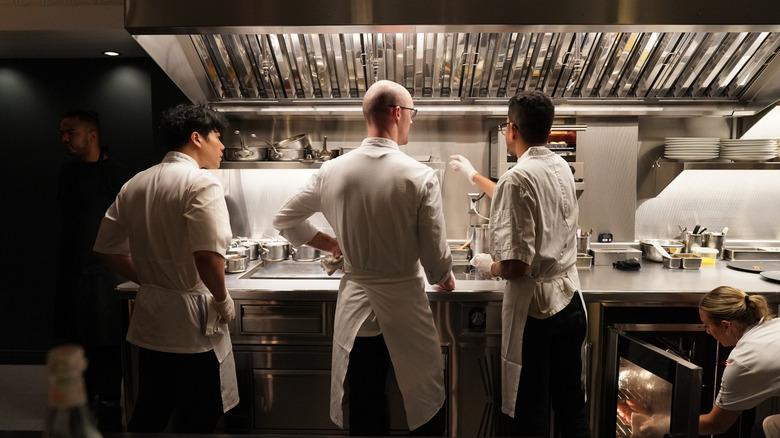Rick Steves Enjoys These 'Splurge-Worthy' Restaurants In Europe For A Gourmet Experience
Picture yourself wandering through historic cities like Paris or Rome, soaking in the colorful nightlife of Berlin or Barcelona, and marveling at the iconic landmarks like the Eiffel Tower or the Colosseum. Beyond Europe's sights, the continent offers immersive cultural experiences, like art museums in Florence or music festivals in Belgium. And the continent's food is a cornerstone of European travel that seamlessly ties it all together. Europe boasts an unparalleled gastronomic landscape. Paris alone is home to over 120 Michelin-starred restaurants that showcase high-end dining that celebrates precision, creativity, and quality.
Yet, diving into this world can feel daunting, especially when trying to balance indulgence with a practical budget. How does one savor Europe's culinary treasures without breaking the bank? In a speech on his YouTube channel, travel guru Rick Steves perhaps surprisingly advises skipping ultra-exclusive Michelin-starred spots. "It's great, but it costs a hundred bucks, you've got to dress up, you've got to book it weeks in advance," Steves said. "And it's pretentious."
A renowned author and television host, Steves has spent decades guiding Americans through the continent's hidden gems, making him a go-to source for practical tips. Having explored Europe extensively, he knows the pitfalls of overpriced tourist traps and champions a way to eat well without the excess. Instead of Michelin-starred establishments, Steves recommends "Michelin-rated" restaurants, particularly those earning Michelin's "Bib Gourmand" designation. Awarded to restaurants serving a quality three-course meal at a reasonable price, these places allow travelers to spend less on food while on vacation and experience gourmet-level dishes in a more relaxed setting. Just don't forget to review these popular European gestures before your trip.
Michelin stars versus Bib Gourmand
The Michelin Guide, which originated from a tire company's promotional effort in the early 1900s, has evolved into a global benchmark for dining excellence. At its core are the coveted stars, awarded anonymously by inspectors who evaluate restaurants based on strict criteria. These include the quality of ingredients, the chef's command over flavors and cooking methods, the unique personality infused into the cuisine, the seamless blending of tastes, and reliability across multiple visits. Restaurants can receive anywhere from one to three stars, each indicating progressively higher levels of achievement.
A one-star establishment offers high-quality cooking that's worth pausing your journey for. Two stars denote excellent fare that merits a detour of your travels, and a three-star rating celebrates exceptional cuisine that deserves a dedicated trip of its own. Chefs worldwide chase these honors, which can transform a restaurant's reputation entirely.
In contrast, the Bib Gourmand award was introduced in 1955 and formalized as a separate category in 1997. It honors eateries that provide outstanding food at accessible prices without the formality of starred venues. Symbolized by Bibendum — the cheerful Michelin Group mascot licking his lips — this category spotlights friendly, approachable spots where quality meets value. To qualify, restaurants usually offer menu options below a local threshold, typically around €36 in Europe or $40 in the U.S. This usually includes a three-course meal, consisting of a starter, main course, and dessert. Inspectors assess the same high standards for ingredients and preparation as stars, but emphasize affordability, diversity in cuisines, and a welcoming atmosphere. This Michelin category has led to a surge in restaurants committed to authentic and flavorful experiences that feel genuine and welcoming instead of elite, something Rick Steves appreciates about them. Bib Gourmand focuses on everyday excellence, making the experience indulgent.
Splurge-worthy Bib Gourmand restaurants across Europe
With thousands of Bib Gourmand options worldwide, Europe offers a vast selection. France leads the way, boasting around 390 such restaurants amid its wealth of starred establishments. This makes it an ideal starting point for food-focused travelers. In Paris, venues like Lai'Tcha blend Asian influences with French techniques in a quiet setting in a bustling section of the city. For seafood lovers, La Méditerranée provides Mediterranean-inspired fare featuring fresh catches in a lively yet affordable atmosphere. Heading south to Nice, La Merenda charms with nostalgic Provençal dishes evoking the region's heritage. These spots allow visitors to experience high-quality food without the high-end prices.
Venturing outside of France, Spain offers more than 200 Bib Gourmand eateries, showcasing its vibrant food scene. In A Coruña, Taberna 5 Mares presents an unconventional gourmet twist in a bright and inclusive environment with harbor views perfect for sampling the dishes within your budget's means. Italy isn't far behind France with nearly 250 Bib Gourmand choices of its own, spanning from regional classics to innovative farm-to-table concepts. Whether you're craving homemade noodles in Tuscany or seafood in Sicily, these restaurants highlight Italy's passion for culinary tradition and soulful dining ethos.
Bib Gourmand spots are splurge-worthy for their ability to combine quality, authenticity, and approachability. Prioritizing them is a Rick Steves-approved method that often feels like a pure travel hack, allowing visitors to get the most out of their food tourism experience.


